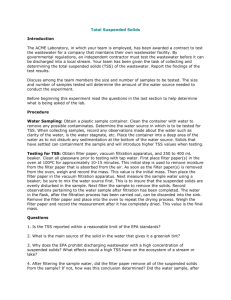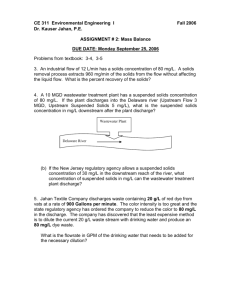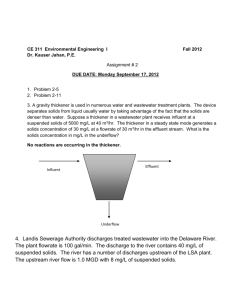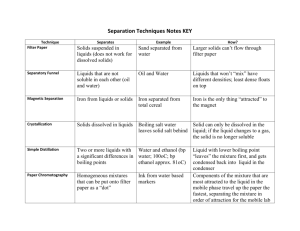Solids
advertisement
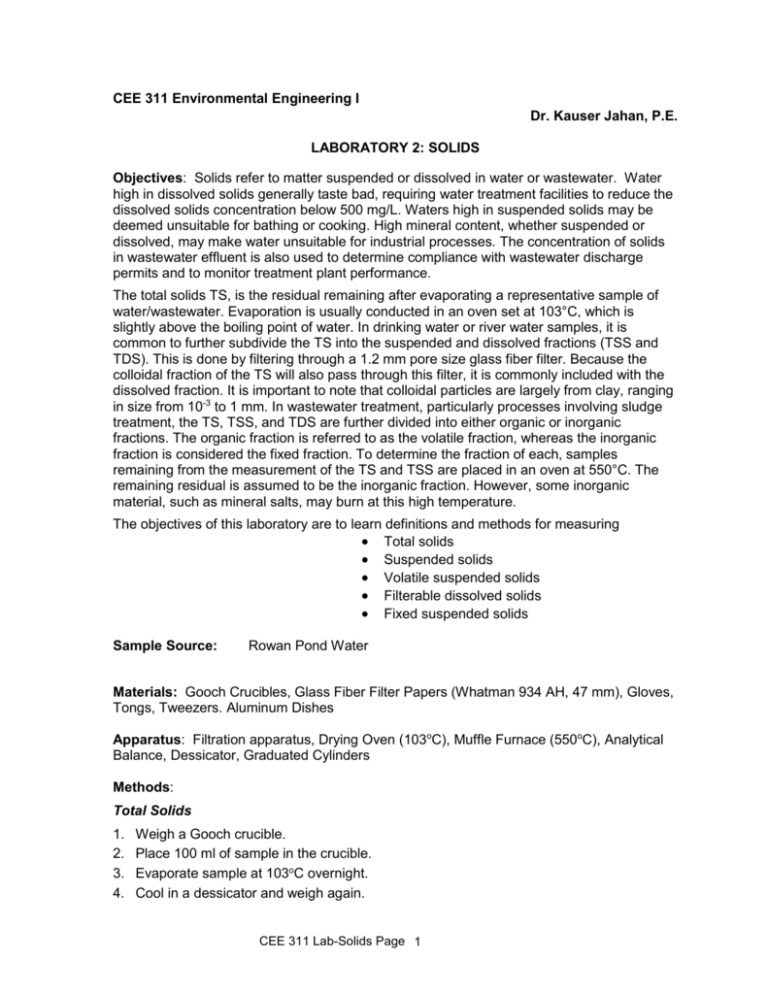
CEE 311 Environmental Engineering I Dr. Kauser Jahan, P.E. LABORATORY 2: SOLIDS Objectives: Solids refer to matter suspended or dissolved in water or wastewater. Water high in dissolved solids generally taste bad, requiring water treatment facilities to reduce the dissolved solids concentration below 500 mg/L. Waters high in suspended solids may be deemed unsuitable for bathing or cooking. High mineral content, whether suspended or dissolved, may make water unsuitable for industrial processes. The concentration of solids in wastewater effluent is also used to determine compliance with wastewater discharge permits and to monitor treatment plant performance. The total solids TS, is the residual remaining after evaporating a representative sample of water/wastewater. Evaporation is usually conducted in an oven set at 103°C, which is slightly above the boiling point of water. In drinking water or river water samples, it is common to further subdivide the TS into the suspended and dissolved fractions (TSS and TDS). This is done by filtering through a 1.2 mm pore size glass fiber filter. Because the colloidal fraction of the TS will also pass through this filter, it is commonly included with the dissolved fraction. It is important to note that colloidal particles are largely from clay, ranging in size from 10-3 to 1 mm. In wastewater treatment, particularly processes involving sludge treatment, the TS, TSS, and TDS are further divided into either organic or inorganic fractions. The organic fraction is referred to as the volatile fraction, whereas the inorganic fraction is considered the fixed fraction. To determine the fraction of each, samples remaining from the measurement of the TS and TSS are placed in an oven at 550°C. The remaining residual is assumed to be the inorganic fraction. However, some inorganic material, such as mineral salts, may burn at this high temperature. The objectives of this laboratory are to learn definitions and methods for measuring Total solids Suspended solids Volatile suspended solids Filterable dissolved solids Fixed suspended solids Sample Source: Rowan Pond Water Materials: Gooch Crucibles, Glass Fiber Filter Papers (Whatman 934 AH, 47 mm), Gloves, Tongs, Tweezers. Aluminum Dishes Apparatus: Filtration apparatus, Drying Oven (103oC), Muffle Furnace (550oC), Analytical Balance, Dessicator, Graduated Cylinders Methods: Total Solids 1. 2. 3. 4. Weigh a Gooch crucible. Place 100 ml of sample in the crucible. Evaporate sample at 103oC overnight. Cool in a dessicator and weigh again. CEE 311 Lab-Solids Page 1 5. Calculate total solids in mg/L. Suspended Solids 1. Prewash glass fiber filters by placing filters (wrinkled side up) on a filtration apparatus and rinsing them each 3 times with 25 ml of DI water. 2. Dry filter papers in a muffle furnace at 550+ 50oC for 15 minutes. 3. Cool the filter papers in a dessicator to room temperature. 4. Label Gooch crucible and weigh with filter paper. Thanks to Student Worker for prewashing filter papers and drying them. 5. Record volume of sample to be filtered. 6. Place filter paper in filtration apparatus and filter the instructed volume of sample. Let sample settle first and add supernatant slowly!! 7. Continue vacuum suction for 30 seconds after filtering is complete. 8. Carefully remove filter paper with tweezers and place it back in the crucible at an angle. 9. Place in drying oven at 105oC for 1.5 hours. 10. Cool in dessicator to room temperature and weigh crucible+filter again. 11. Calculate suspended solids and filterable dissolved solids. SAVE FILTER PAPER FOR VSS ANALYS ES Volatile Suspended Solids 1. Place Gooch crucible and filter from previous experiment in a muffle furnace at 550oC for 15-20 minutes. 2. Cool in dessicator to room temperature and weigh crucible+filter again. 3. Calculate fixed suspended solids and volatile suspended solids. SAFETY: The ban on horseplay needs no explanation. Gloves are to be worn during the sample handling process. Extra precaution should be taken when handling samples for VSS analyses in the muffle furnace. Use appropriate gloves and tongs. SAMPLE DATA SHEET All data must be recorded in your laboratory notebooks. Yellow pages must be included with the laboratory report. TS Total Solids (TS) Sample ID # Sample Volume (V) Initial Weight of Crucible (Wo) CEE 311 Lab-Solids Page 2 Final Weight of Crucible + Sample (Wf) Wf Wo V TSS, FDS, FSS, VSS Sample ID # SS Sample Volume (V) Wd Wo V Initial Weight of Crucible + Filter Paper (Wo) VSS Wd Wf V Final Weight of Crucible + Filter Paper (105oC) (Wd) FSS Wf Wo V Final Weight of Crucible + Filter Paper (550oC) (Wf) TS – TSS = TDS LABORATORY REPORT (Hand written reports will not be accepted. Use computer spreadsheets and word processors as necessary. Sample calculations should be presented on engineering paper.) Objectives: Indicate objectives of this laboratory. Method: Indicate what method was used for this laboratory (e.g., Standard Methods…….) Results 1. Report raw data in a tabular form with appropriate headings/titles/labels. 2. Include Excel worksheet showing calculations with formulae. 3. Report TS, TSS, VSS, FSS on a separate sheet of paper with appropriate units. Discussion Indicate with schematic, locations at a conventional WWTP where solids are measured. Indicate the rationale behind measuring solids at these locations. References http://civil.engr.siu.edu/nsflab/Manuals/Main_Environmental.htm Standard Methods for the Examination of Water and Wastewater, 20th Ed. Published jointly by APHA, AWWA and WPCF, 2004. CEE 311 Lab-Solids Page 3 Figure 1. Generalized schematic of steps to determine TS, VS, and FS. Figure 2. Generalized schematic of steps to determine TSS, VSS, and FSS. TSS regulated in wastewater 30 mg/L; varies for surface water; The surface water criterion is 25 mg/L in trout waters and 40 mg/L in non-trout waters in New Jersey VSS indicates organic content of sample; used for measure of bacteria in WWTPs TDS is related to conductivity; Drinking water limit at 500 mg/L ytpically CEE 311 Lab-Solids Page 4
